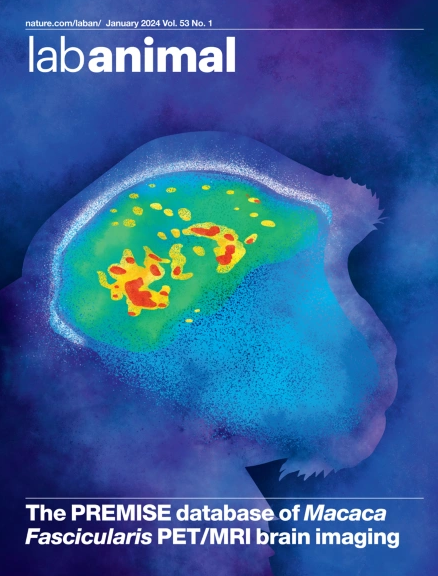Thermoneutral environment improves mouse welfare and reduces stress in metabolic cages.
IF 3.9
3区 农林科学
Q1 VETERINARY SCIENCES
引用次数: 0
Abstract
Metabolic cages (MCs) are often used to collect feces and urine samples. However, the housing of mice in MCs can be stressful, potentially affecting parameters of interest. Here we compare our standard protocol for individual MC housing (4 days at 23 °C: 3 days of permanent acclimatization followed by 24 h sampling (MC23)) with a short-term intermittent acclimatization protocol (3 h of MC housing for 3 days plus 24 h sampling (accMC23)), the provision of a nest (4 days at 23 °C in MC (nest-MC23)) and MC housing at thermoneutrality (4 days at 30 °C, MC30)). C57BL6/N mice were implanted with telemetric transmitters to collect electrocardiograms, blood pressure, core body temperature and activity data. Single-housed mice in the MC at 23 °C had lower core body temperatures and higher heart and respiratory rates than mice in the MC30 group. Mice housed in MCs at 23 °C exhibited increased food consumption and weight loss, combined with significantly increased expression of messenger RNAs of key molecules in brown fat compared with mice housed in MCs at 30 °C. They also showed increased corticosterone levels. Some male mice of the MC23 and accMC23 groups exhibited episodes of reduced core body temperature and reduced blood pressure and heart rate. Our study demonstrates that housing mice in MCs at 23 °C has a substantial impact on their physiology and welfare due to a substantial cold stress. MC housing at thermoneutrality (30 °C) provides a simple solution to improve mouse welfare. Furthermore, the results showed that a single acclimatization period had the same effect as repeated exposure to the MCs and, therefore, provided no additional benefit.热中性环境改善代谢笼小鼠福利,减少应激。
代谢笼(MCs)常用于收集粪便和尿液样本。然而,小鼠在MCs中的住房可能是有压力的,可能会影响感兴趣的参数。在这里,我们比较了单个MC住房的标准方案(在23°C下4天:3天永久适应,然后24小时采样(MC23))与短期间歇性适应方案(MC住房3天加上24小时采样(accMC23)),提供巢(MC在23°C下4天(巢-MC23))和热中性MC住房(30°C下4天,MC30))。给C57BL6/N小鼠植入遥测发射机,收集其心电图、血压、核心体温和活动数据。与MC30组相比,23°C MC组的单房小鼠核心体温较低,心率和呼吸速率较高。与30°C的小鼠相比,在23°C的MCs中饲养的小鼠表现出食物消耗增加和体重减轻,并且棕色脂肪关键分子信使rna的表达显著增加。他们的皮质酮水平也有所上升。MC23和accMC23组的一些雄性小鼠表现出核心体温降低、血压和心率降低的症状。我们的研究表明,由于大量的冷应激,在23°C的MCs中饲养小鼠对其生理和福利产生了重大影响。热中性(30°C)的MC住房为改善小鼠福利提供了一种简单的解决方案。此外,结果表明,单一驯化期与重复暴露于MCs具有相同的效果,因此没有提供额外的益处。
本文章由计算机程序翻译,如有差异,请以英文原文为准。
求助全文
约1分钟内获得全文
求助全文
来源期刊

Lab Animal
农林科学-兽医学
CiteScore
0.60
自引率
2.90%
发文量
181
审稿时长
>36 weeks
期刊介绍:
LabAnimal is a Nature Research journal dedicated to in vivo science and technology that improves our basic understanding and use of model organisms of human health and disease. In addition to basic research, methods and technologies, LabAnimal also covers important news, business and regulatory matters that impact the development and application of model organisms for preclinical research.
LabAnimal's focus is on innovative in vivo methods, research and technology covering a wide range of model organisms. Our broad scope ensures that the work we publish reaches the widest possible audience. LabAnimal provides a rigorous and fair peer review of manuscripts, high standards for copyediting and production, and efficient publication.
 求助内容:
求助内容: 应助结果提醒方式:
应助结果提醒方式:


